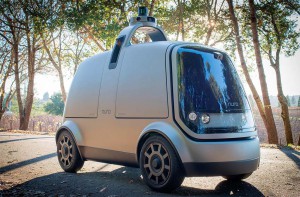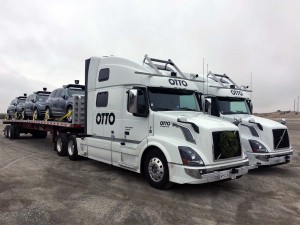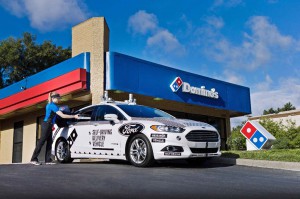It looks like a four-wheeled toaster, but when the Nuro R1 starts popping up later this year it will be bringing packages from online and local retail shops, according to the company’s founders.
The race to put self-driving vehicles on the road is rapidly heating up, and it’s a question of which will come first: robot taxis or automated delivery vans. If Nuro has its way, it will get a head start on companies like Waymo and General Motors, which hope to launch the first driverless ride-sharing services sometime in 2019.
Considering the tens of billions of dollars in goods that roll across the nation’s highways each year, experts see a potentially lucrative market for driverless long-haul trucks. Several companies have already demonstrated prototypes, including Uber subsidiary Otto. But Nuro is targeting the final leg of the journey.
“We designed the R1 to be flexible, so it can be used for everything from your e-commerce packages to deliveries from a local dry cleaner,” said Dave Ferguson who, along with Nuro co-founder Jiajun Zhu, previously worked on Google’s self-driving car program.
They’ve been joined by an assortment of autonomous vehicle engineers who’ve logged time at General Motors, Tesla and on Apple’s still secret self-driving program. Nuro claims to have locked down $92 million in funding from several high-profile venture capital firms, including Baynyan Capital and Greylock Partners.
(Waymo buying “1,000s” of Chrysler vans for driverless ride-sharing service. Click Here for the latest news.)
Who Nuro’s customers might be the start-up isn’t yet revealing. But there are plenty of potential markets, both traditional delivery services FedEx and UPS, as well as start-ups like DoorDash and Postmates expressing interest in going driverless. Amazon recently filed a patent on what it described as a self-driving delivery vehicle. And Toyota showed off a similarly toaster-like concept, the e-Palette, at the annual Consumer Electronics Show earlier this month. It is envisioned as a multi-purpose vehicle that might serve as a ride-hailing vehicle during rush hour and then deliver packages at other times.
Last autumn, Ford teamed up with Domino’s on a test near the pizza company’s Ann Arbor, Michigan headquarters. It relied on Ford Fusion sedans modified to drive autonomously – there actually was a backup “operator” in the vehicle but the windows were blacked out. Customers would place an order and then get an alert when one of the prototypes pulled up to their home or office with a code that could be entered into a keypad on the side of the vehicle. The customer then retrieved the pizza out of a special window.
Another test program in Northern California is being run by start-up Udelv and backed by the high-end Draeger’s Market chain. But, like the Ford/Domino’s project, the partners are using modified vans with a backup driver onboard.
Nuro’s ungainly little R1 was developed entirely in-house and will operate entirely on its own with no backup driver onboard.
(Majority of Americans still wary of self-driving vehicles, but confidence growing. Click Here for results of new surveys.)
There’s the potential cost-savings which can add up quickly by taking the driver out of the truck. And freight and delivery services point out that there’s currently a severe shortage of drivers, to begin with.
“We’ve built the full software stack from scratch. There are a lot of components that are shared with general self-driving, and some things that are a bit different,” said co-founder Ferguson, stressing that Nuro is “geared toward this passenger-less, goods-only transportation.”
The company is already running a small fleet of prototypes to test the capabilities of the R1. And while it has received a permit from California regulators to operate in the state it must still wait for approval from the National Highway Traffic Safety Administration if it wants to roll out across country. That said, Congress is considering proposals that could soon permit automakers and tech companies to begin rolling out hundreds of thousands of vehicles on public roads across the country.
As the Domino’s experiment underscored, unmanned delivery vehicles like the Nuro R1 face some potentially obstacles, however, notably one dubbed the “last 100-foot challenge.” It’s one thing for a driverless vehicle to pull up to an address, but getting a package into a customer’s hands is another matter. For the pizza service’s customers the trade-off was not having to tip a driver. But it’s less clear whether customers for the likes of a UPS, Amazon or a grocery store would see the benefit in having to go outside for their packages, especially in inclement weather.
Nuro considered, but ultimately abandoned, the idea of making R1 capable of also driving on sidewalks. But potential competitors are looking for ways to cross that last 100 feet. Daimler AG recently ran an experiment in Zurich using one of its vans equipped with a pair of drones that could drop packages on a customer’s doorstep. Amazon has also been considering ways to use drones for deliveries. And another start-up, Starship Technologies has already begun testing delivery robots designed to work on sidewalks in several U.S. and European locations.
One way or the other, don’t be surprised to see some of your goods, whether groceries or packages from Amazon, delivered robotically in the near future.
(Nikola Motors picks Phoenix for $1b hydrogen semi-truck plant. Click Here for the breaking news.)




